Papers by FORNESSA RANDAL

Journal of Clinical Oncology
TPS6654 Background: The Covid-19 pandemic has caused a significant disruption in healthcare utili... more TPS6654 Background: The Covid-19 pandemic has caused a significant disruption in healthcare utilization. The halt and delay of CRC screening have led to a substantial decline in CRC screening rates. The backlog and the slow resuming of CRC screening will have significant consequences. Although COVID-19 created challenges in CRC screening, it also presents an opportunity for potential innovative approaches that may improve patient compliance and screening rates, such as a blood-based CRC screening test which can be done at the point of care without preparation. Adherence to CRC screening is poor among vulnerable populations even before COVID-19, and these populations disproportionately receive health care in safety-net settings, such as federally qualified health centers (FQHCs). Thus, FQHCs play a significant role in improving CRC-related outcomes and ensuring health equity. This study will examine patient compliance with CRC screening by offering another option, a blood-based scree...
Preventive Medicine Reports

Journal of Transcultural Nursing
Background:Underrepresented persons are often not included in biomedical research. It is unknown ... more Background:Underrepresented persons are often not included in biomedical research. It is unknown if the general Asian American population is being represented in All of Us. The purpose of this study was to compare the Asian demographic data in the All of Us cohort with the Asian nationally representative data from the American Community Survey.Method:Demographic characteristics and health literacy of Asians in All of Us were examined. Findings were qualitatively compared with the Asian data in the 2019 American Community Survey 1-year estimate.Results:Compared with the national composition of Asians, less All of Us participants were born outside the United States (64% vs 79%), were younger, and had higher levels of education (76% vs 52%). Over 60% of All of Us participants reported high levels of health literacy.Conclusion:This study had implications for the development of strategies that ensure diverse populations are represented in biomedical research.
Progress in Community Health Partnerships: Research, Education, and Action
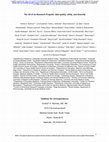
ImportanceThe All of Us Research Program hypothesizes that accruing one million or more diverse p... more ImportanceThe All of Us Research Program hypothesizes that accruing one million or more diverse participants engaged in a longitudinal research cohort will advance precision medicine and ultimately improve human health. Launched nationally in 2018, to date All of Us has recruited more than 345,000 participants. All of Us plans to open beta access to researchers in May 2020.ObjectiveTo demonstrate the quality, utility, and diversity of the All of Us Research Program’s initial data release and beta launch of the cloud-based analysis platform, the cloud-based Researcher Workbench.EvidenceWe analyzed the initial All of Us data release, comprising surveys, physical measurements (PM), and electronic health record (EHR) data, to characterize All of Us participants including self-reported descriptors of diversity. Data depth, density, and quality were evaluated using medication sequencing analyses for depression and type 2 diabetes. Replication of known oncologic associations with smoking e...
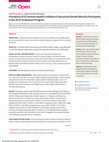
JAMA Network Open
ImportanceLimited data describe the health status of sexual or gender minority (SGM) people due t... more ImportanceLimited data describe the health status of sexual or gender minority (SGM) people due to inaccurate and inconsistent ascertainment of gender identity, sex assigned at birth, and sexual orientation.ObjectiveTo evaluate whether the prevalence of 12 health conditions is higher among SGM adults in the All of Us Research Program data compared with cisgender heterosexual (non-SGM) people.Design, Setting, and ParticipantsThis cross-sectional study used data from a multidisciplinary research consortium, the All of Us Research Program, that links participant-reported survey information to electronic health records (EHR) and physical measurements. In total, 372 082 US adults recruited and enrolled at an All of Us health care provider organization or by directly visiting the enrollment website from May 31, 2017, to January 1, 2022, and were assessed for study eligibility.ExposuresSelf-identified gender identity and sexual orientation group.Main Outcomes and MeasuresTwelve health cond...
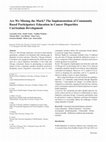
Journal of Racial and Ethnic Health Disparities, 2014
Objective The Chicago south side, even more so than national populations, continues to be burdene... more Objective The Chicago south side, even more so than national populations, continues to be burdened with widening gaps of disparities in cancer outcomes. Therefore, Chicago community members were engaged in addressing the following content areas for a cancer disparities curriculum: (1) the south side Chicago community interest in participating in curriculum design, (2) how community members should be involved in designing cancer disparities curriculum, and (3) what community members believe the curriculum should address to positively impact their community. Methods Eighty-six community members from 19 different zip code areas of Chicago attended the deliberative session. A survey composed of three quantitative and three short-answer content questions was analyzed. Results The majority of participants were from the south side of Chicago (62 %) and females (86 %). Most, 94 %, believed community members should be involved in cancer disparities curriculum development. Moreover, 56 % wanted to be involved in designing the curriculum, and 61 % reported an interest in taking a course in cancer disparities. Three categorical themes were derived from the qualitative questions: (1) community empowerment through disparities education-"a prescription for change," (2) student skill development in community engagement and advocacy training, and (3) community expression of shared experiences in cancer health disparities. Conclusion The community provided valuable input for curricular content and has an interest in collaborating on cancer disparities curriculum design. Community participation must be galvanized to improve disparities curricular development and delivery to successfully address the challenges of eliminating disparities in health. Keywords Community based participatory education. Cancer disparities. Medical education. Curriculum development. Health disparities. Urban health. African American health. Deliberative methods and community members
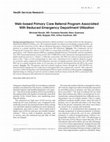
Family medicine, 2006
BACKGROUND AND OBJECTIVES Uninsured patients without a primary care home tend to use the emergenc... more BACKGROUND AND OBJECTIVES Uninsured patients without a primary care home tend to use the emergency department (ED) for primary care. We examined whether an enhanced scheduling system for follow-up care from the University of New Mexico Hospital Emergency Department (UNMH-ED) that assigns patients to a family medicine home can decrease ED utilization. METHODS The Community Access Program for Central New Mexico (CAP-NM) is a consortium of primary care safety net provider organizations. CAP-NM developed a HIPAA-compliant (Health Insurance Portability and Accountability Act), Web-based information system used by the UNMH-ED to refer uninsured, unassigned patients to family medicine practices ("homes") within the consortium. The Web site referral system operated 24 hours a day, 7 days a week; printed maps to clinic sites; and listed services offered. Analysis of quality assurance data compared (1) ED utilization outcomes of eligible patients referred by the CAP-NM Web site to a...

Many evidence-based interventions (EBIs) found to be effective in research studies often fail to ... more Many evidence-based interventions (EBIs) found to be effective in research studies often fail to translate into meaningful patient outcomes in practice. The purpose of this study was to identify facilitators and barriers that affect the implementation of three EBIs to improve colorectal cancer (CRC) screening in an urban federally qualified health center (FQHC) and offer actionable recommendations to improve future implementation efforts. We conducted 16 semi-structured interviews guided by the Consolidation Framework for Implementation Research (CFIR) to describe diverse stakeholders’ implementation experience. The interviews were conducted in the participant’s clinic, audio-taped, and professionally transcribed for analysis. We used the five CFIR domains and 39 constructs and subconstructs as a coding template to conduct a template analysis. Based on experiences with the implementation of three EBIs, stakeholders described barriers and facilitators related to the intervention char...

ABSTRACT Tobacco use is the single most preventable cause of disease, disability, and death in th... more ABSTRACT Tobacco use is the single most preventable cause of disease, disability, and death in the United States, but low socioeconomic African American communities on Chicago’s Southside continue to see a surge in flavored tobacco product marketing via cultural sterotypes, ad placement and price reduction. Despite the FDA ban on all tobacco flavoring, menthol was excluded. Menthol tobacco flavoring is consumed almost exclusively by African American smokers (85%) and is linked to the steady increase of cancer mortality rates among African Americans. Chicago State University (CSU) a minority serving university (MSU) and University of Chicago Comprehensive Cancer Center (UCCCC) have formed the Chicago Southside Cancer Disparities Initiative (CSCDI) to provide a pipeline of biomedical and cancer research education for underrepresented minority students. The partnership uses a community based participatory research approach to engage the community in curriculum development in an effort to meet the needs of the next generation of health professionals. Using the participatory approach, the community identified the unjust marketing practice of menthol flavored tobacco in the African American community as a primary instructional focus. The presentation will highlight the CSCDI’s use of community town hall forums, collaboration with other Chicago university researchers and partnership with the African American Tobacco Control Leadership Council to develop MPH coursework exploring this unique social justice issue. Presenters will share evaluation results and the subsequent work of the Chicago Department of Public Health that resulted in the passing of cutting edge tobacco control legislation and increased taxation on menthol flavored tobacco products.
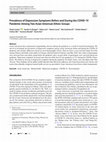
Journal of Immigrant and Minority Health
Asian Americans have experienced compounding stressors during the pandemic as a result of racial ... more Asian Americans have experienced compounding stressors during the pandemic as a result of racial discrimination. We aim of to investigate the prevalence of depression symptoms among Asian Americans before and during the COVID-19 pandemic and examine differences based on socio-demographic factors. Data are from a cross-sectional study (N = 636) among Chinese and South Asian adults in Chicago collected between February and May 2020. One cohort of participants were surveyed from each ethnic group before the pandemic and a second cohort of participants were surveyed during the pandemic. Depression symptoms increased more than twofold , from 9% pre-pandemic to 21% during the COVID-19 pandemic. We found an increase in depression symptoms during the pandemic for South Asians, men and adults older than 30 years. These findings call for public health education that effectively addresses anti-Asian harassment and violence and ensure that culturally competent mental health services are provided to Asian Americans from diverse ethnic backgrounds.
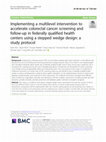
Implementation Science
Background Screening for colorectal cancer (CRC) not only detects disease early when treatment is... more Background Screening for colorectal cancer (CRC) not only detects disease early when treatment is more effective but also prevents cancer by finding and removing precancerous polyps. Because many of our nation’s most disadvantaged and vulnerable individuals obtain health care at federally qualified health centers, these centers play a significant role in increasing CRC screening among the most vulnerable populations. Furthermore, the full benefits of cancer screenings must include timely and appropriate follow-up of abnormal results. Thus, the purpose of this study is to implement a multilevel intervention to increase rates of CRC screening, follow-up, and referral-to-care in federally qualified health centers, as well as simultaneously to observe and to gather information on the implementation process to improve the adoption, implementation, and sustainment of the intervention. The multilevel intervention will target three different levels of influences: organization, provider, and...
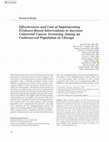
Health Promotion Practice
With funding from the Centers for Disease Control and Prevention’s Colorectal Cancer Control Prog... more With funding from the Centers for Disease Control and Prevention’s Colorectal Cancer Control Program, The University of Chicago Center for Asian Health Equity partnered with a federally qualified health center (FQHC) to implement multiple evidence-based interventions (EBIs) in order to improve colorectal cancer (CRC) screening uptake. The purpose of this study is to determine the effectiveness and cost of implementing a provider reminder system entered manually and supplemented with patient reminders and provider assessment and feedback. The FQHC collected demographic characteristics of the FQHC and outcome data from January 2015 through December 2015 (preimplementation period) and cost from January 2016 through September 2017 (implementation period). Cost data were collected for the implementation period. We report on the demographics of the eligible population, CRC screening order, completion rates by sociodemographic characteristics, and, overall, the effectiveness and cost of im...

Tobacco use is the single most preventable cause of disease, disability, and death in the United ... more Tobacco use is the single most preventable cause of disease, disability, and death in the United States, but low socioeconomic African American communities on Chicago’s Southside continue to see a surge in flavored tobacco product marketing via cultural sterotypes, ad placement and price reduction. Despite the FDA ban on all tobacco flavoring, menthol was excluded. Menthol tobacco flavoring is consumed almost exclusively by African American smokers (85%) and is linked to the steady increase of cancer mortality rates among African Americans. Chicago State University (CSU) a minority serving university (MSU) and University of Chicago Comprehensive Cancer Center (UCCCC) have formed the Chicago Southside Cancer Disparities Initiative (CSCDI) to provide a pipeline of biomedical and cancer research education for underrepresented minority students. The partnership uses a community based participatory research approach to engage the community in curriculum development in an effort to meet t...

Family Medicine, Apr 1, 2006
Uninsured patients without a primary care home tend to use the emergency department (ED) for prim... more Uninsured patients without a primary care home tend to use the emergency department (ED) for primary care. We examined whether an enhanced scheduling system for follow-up care from the University of New Mexico Hospital Emergency Department (UNMH-ED) that assigns patients to a family medicine home can decrease ED utilization. The Community Access Program for Central New Mexico (CAP-NM) is a consortium of primary care safety net provider organizations. CAP-NM developed a HIPAA-compliant (Health Insurance Portability and Accountability Act), Web-based information system used by the UNMH-ED to refer uninsured, unassigned patients to family medicine practices ("homes") within the consortium. The Web site referral system operated 24 hours a day, 7 days a week; printed maps to clinic sites; and listed services offered. Analysis of quality assurance data compared (1) ED utilization outcomes of eligible patients referred by the CAP-NM Web site to a family medicine home to (2) outcomes of controls discharged from the ED in the usual manner. The 756 patients referred to family medicine homes through the CAP-NM Web site demonstrated a significant 31% reduction in subsequent ED visits compared to controls. This reduction was most evident among those who had infrequent ED use before institution of the program. Implementing an enhanced referral system to family medicine homes from the ED is associated with decreased subsequent ED utilization by uninsured patients.

Tobacco use is the single most preventable cause of disease, disability, and death in the United ... more Tobacco use is the single most preventable cause of disease, disability, and death in the United States, but low socioeconomic African American communities on Chicago’s Southside continue to see a surge in flavored tobacco product marketing via cultural sterotypes, ad placement and price reduction. Despite the FDA ban on all tobacco flavoring, menthol was excluded. Menthol tobacco flavoring is consumed almost exclusively by African American smokers (85%) and is linked to the steady increase of cancer mortality rates among African Americans. Chicago State University (CSU) a minority serving university (MSU) and University of Chicago Comprehensive Cancer Center (UCCCC) have formed the Chicago Southside Cancer Disparities Initiative (CSCDI) to provide a pipeline of biomedical and cancer research education for underrepresented minority students. The partnership uses a community based participatory research approach to engage the community in curriculum development in an effort to meet t...

Cancer, Oct 25, 2018
This report details the cost effectiveness of a non-nurse patient navigation (PN) program that wa... more This report details the cost effectiveness of a non-nurse patient navigation (PN) program that was implemented at the University of Chicago Medical Center to increase colonoscopy-based colorectal cancer (CRC) screening. The authors investigated the impact of the PN intervention by collecting process measures. Individuals who received navigation were compared with a historic cohort of non-navigated patients. In addition, a previously validated data-collection instrument was tailored and used to collect all costs related to developing, implementing, and administering the program; and the incremental cost per patient successfully navigated (the cost of the intervention divided by the change in the number who complete screening) was calculated. The screening colonoscopy completion rate was 85.1% among those who were selected to receive PN compared with 74.3% when no navigation was implemented. With navigation, the proportion of no-shows was 8.2% compared with 15.4% of a historic cohort of non-navigated patients. Because the perceived risk of noncompletion was greater among those who received PN (previous no-show or cancellation, poor bowel preparation) than that in the historic cohort, a scenario analysis was performed. Assuming no-show rates between 0% and 50% and using a navigated rate of 85%, the total incremental program cost per patient successfully navigated ranged from $148 to $359, whereas the incremental intervention-only implementation cost ranged from $88 to $215. The current findings indicate that non-nurse PN can increase colonoscopy completion, and this can be achieved at a minimal incremental cost for an insured population at an urban academic medical center.











Uploads
Papers by FORNESSA RANDAL